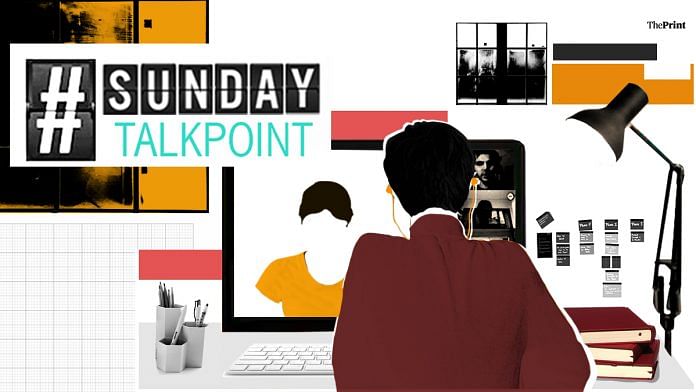Businessman Anand Mahindra took to Twitter to denounce the word ‘webinar’ and asked for it to be ‘banished’ from the dictionary. Webinars, which are seminars conducted online using video conferencing platforms, have become the go-to mode of communication among companies, colleges and experts during the coronavirus-induced lockdowns.
ThePrint asks: How can you make a webinar exciting?
You can’t make webinars fun. But invest in lighting and look at the camera, not screen
 Regina Mihindakulusuriya
Regina Mihindakulusuriya
Senior Correspondent, ThePrint
You can’t make a webinar interesting or exciting. But here are some things you could try:
Learn to look at the tiny hole with the camera
The biggest mistake amateur webinar hosts makes is they look at the screen and not the tiny hole with the camera. If you’re not looking at the camera, then you’re not making eye contact with your audience. In real life, if you’re not making eye contact with your audience, your audience will be bored. The same logic applies here.
2. Invest in good lighting
Get yourself a ring light and place it near your camera so that your face is fully illuminated. Bad lighting, dull lighting, dim lighting are a huge no-no if you’re trying to make your webinar exciting
3. Do something provocative
It could be telling a joke, wearing a goofy costume, a silly stunt like drinking a pitcher of margarita, do something that will provoke a feeling, any kind of feeling — it’ll make things more memorable for your viewer.
4. Keep things short
Don’t drone on just because you have a paid Zoom subscription. Please keep your webinars short, in fact, avoid having one, if you can.
Most online meeting apps have the chat option — students, new attendees should use it
 Sandhya Ramesh
Sandhya Ramesh
Senior assistant editor, ThePrint
To make webinars engaging and fun, we don’t necessarily need to emulate real-life conferences and meetings. What we do need to emulate is social interaction through physical distancing.
As online meetings and discussions can be new and unfamiliar to attendees, ice breaker discussions can be a good way to kickstart things. Webinars can be made more fun by encouraging team activities and more interaction between peers. Most meeting apps have a chat option, and it’s always good to encourage attendees to send private chats if they feel the need to.
The chat function is also useful during lectures if there are teaching assistants who can answer attendee questions in real-time. This inspires a lot of confidence in terms of understanding and clearing doubts as and when they occur.
Of course, it’s important to be prepared on all fronts when it comes to technical aspects. Microphone and camera checks should be performed beforehand so that attendees don’t feel like their time is being wasted. Encouraging discussions on social media or email threads afterward is a great way to retain engagement.
Everyone can do a webinar — it’s cheap and easy. But the trick is to hold your audience past first 10 minutes
 Mohana Basu
Mohana Basu
Special correspondent, ThePrint
Among the many first-world problems that weeks of staying indoors has brought home are webinars. Everyone is doing one. The idea seems to be neat — it is low cost, convenient, and reaches a much wider audience.
Instead of booking a venue, arranging catering and travel for guests, we now just need to send a few emails, or phone calls and set up a link. But is that enough to get your audience to stick through the webinar beyond the first 10 minutes?
Internet tools bring us a range of possibilities. If one must adapt to the world of webinars, one must learn new skill sets as well. Just because it is online and does not cost much, does not mean you should host a webinar that lasts hours.
One needs to start using tools beyond PowerPoint — short videos and animations need to act as visual reliefs. Whiteboards can be fun too, but only if you are good at using it. No one wants to squint and decipher scribbles. Also, engage viewers by taking their questions via chats. Investing in developing better visual aid will go a long way in making webinars interesting and successful.
Webinars should be about conversations, not endless monologues
 Nayanima Basu
Nayanima Basu
Diplomacy editor, ThePrint
Webinars are certainly here to stay for a long time. Not only is it a way to prevent the spread of the virus, but slowly organisations and institutions are realising that these are cost-effective and a more efficient way of reaching out to a much larger audience than. However, there has to be a certain kind of ethos that needs to be built up in order to make webinars more exciting. Just as you don’t cook all the time because you have a kitchen, the same way you don’t organise webinars just because you own a laptop or you have apps like Zoom, Skype or Bluejeans at your easy disposal.
This sudden craze and the mad rush of organising webinars have to somewhere be tamed. Not everyone can be logged in at the same time. Hence, selection of topics and panelists is key. And most importantly, webinars should be about conversations, not monologues.
Then comes the factor of audience engagement, because that is extremely critical in today’s time where everyone wants to be heard. It’s important people listen to the content, understand it and be educated on the topic rather than making judgements about the interviewer or the interviewee.
If countries like India have to now depend more on webinars for public or academic discourse or for work purposes, then seamless internet connectivity is crucial. No more can governments around the world be unreasonable on issues such as data privacy, data localisation or rolling out of 5G networks. It has to be accessible and affordable going forward.
Also read: Is the future of cinema expensive, hygiene-friendly theatres or at-home Netflix experiences?
By Pia Krishnankutty, journalist at ThePrint







Excellent information on webinars.
This write up is the need of the hour. Kudos to you.